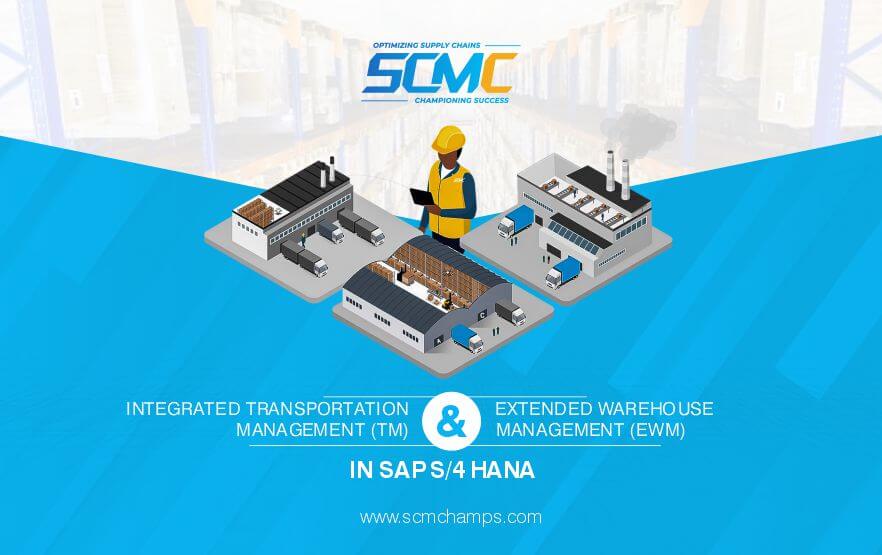
In today’s fast-paced logistics landscape, more than ever, the need for efficient cost-effective supply chain management is driving the call. SAP S/4HANA will thus be a powerful tool in handling the transportation and warehousing activities of organizations with perfectly amalgamated Transportation Management (TM) and Extended Warehouse Management (EWM), thereby allowing companies to have a combined system that will improve end-to-end visibility while minimizing operational costs and ensuring optimal resource utilization. Let’s demonstrate how TM and EWM are combined in SAP S/4HANA to enable a business to transform its logistics operations.
What is SAP TM and EWM?
The strong module of SAP S/4HANA includes SAP Transportation Management or TM, which holds designs to handle and influence transportation management functions, including planning, optimization, freight management, and tracking. TM ensures that all logistics tasks are conducted efficiently, effectively, and in a highly compliant manner, optimizing and maintaining them through full visibility across all modes of transport. It helps companies reduce transportation costs, maximize service levels, and indeed improve customer satisfaction.
SAP EWM provides an integrated solution covering the entire warehouse operations. Using EWM, businesses could manage their picking and packing as well as shipping processes coupled with effective storage management and goods movement with exact figures. Real-time data concerning stock and resources optimize the storage space, cut the pick time, and enhance inventory accuracy.
In an SAP S/4HANA environment, these modules combined form a comprehensive framework in which the transport module harmonizes and synchronizes the warehouse-related activities to make the supply chain efficient and inexpensive.
The Advantages of TM and EWM Integration with SAP S/4HANA
The integration of TM and EWM provides numerous benefits that make logistics operations faster, more accurate, and cost-efficient. Some of its advantages are as follows:
1. Better Supply Chain Visibility: Transportation and warehouse data are brought together for better visibility into the whole supply chain. Real-time data leads to quicker decision-making with an ability to change to prompt response to any change in demand or supply.
2. Improved Resource Optimization: The TM and EWM combined approach optimizes resource usage by taking the best routes for transport and warehouse activities through appropriate allocation. This reduces idle time in utilizing labor and space in a warehouse.
3. Cost Efficiency: Logistics will reduce trucking and warehousing costs for the business. Optimized load planning, route management, and picking processes will all contribute to lower operational expenses.
4. Enhanced Customer Satisfaction: Proper tracking and timely delivery schedules will ensure on-time delivery, thus enhancing customer satisfaction and trustworthiness with the business.
5. Better Inventory Management: EWM gives actual stock levels when TM manages transport operations, thus making for better inventory forecasting, reduced stockouts, and minimal overstock scenarios.
Key Features of TM and EWM Integration in SAP S/4HANA
SAP S/4HANA integrates TM with EWM to provide highly valued advanced features for logistics processes.:
a) Automatic Freight Booking and Tracking: TM calculates and books freight automatically while giving real-time tracking for goods in transit, ensuring smooth coordination with warehouse operations.
b) Warehouse-Driven Shipping Process: EWM handles order picking and packing, and TM schedules transportation accordingly, minimizing delays and optimizing dock usage.
c) Load and Route Optimization: TM uses sophisticated algorithms in load planning and route optimization. This helps coordinate the picking and packing processes of EWM better.
d) Better Collaboration Tools: With transportation and warehousing data integrated, businesses can communicate better between the departments concerned and respond quickly to a possible issue in logistics.
e) Event Management and Monitoring: With real-time event tracking, TM and EWM can monitor events quickly and respond rapidly to unexpected disruptions such as delayed shipments for TM and damaged goods, respectively, that consequently minimize operational impact.
How to Implement Integrated TM and EWM in SAP S/4HANA?
Implementing TM and EWM integration requires a strategic approach to ensure smooth deployment and maximum benefit. Here are some steps to consider:
1. Assess Business Requirements: Evaluate your organization’s specific needs, including transport modes, warehouse capacity, and customer delivery expectations, to determine the features of TM and EWM required for optimal performance.
2. Develop a Unified Data Model: A successful integration depends on consolidating data flows across TM and EWM. Ensure data integrity between warehouse, transportation, and external partners for real-time visibility.
3. Customize Workflows: Adjust and fine-tune TM and EWM workflows according to business processes. For instance, optimize routing and freight booking within TM and customize picking and packing processes in EWM.
4. Leverage Automation: Enable automation features within TM and EWM for tasks such as load planning, freight cost calculation, and warehouse replenishment. Automation reduces human intervention and increases accuracy.
5. Monitor and Optimize: KPIs on transportation and warehouse performance should be monitored constantly after the implementation. This way, the insights can then drive iterated improvement of process efficiency as well as resource usage.
How Can SCM Champs Help with SAP TM and EWM Integration?
At SCM Champs, our SAP consulting team focuses on the implementation of TM and EWM in SAP S/4HANA with perfect implementation according to your business needs. To us, clients get an optimized framework for logistics: cost savings and operational efficiency increase. Our services incorporate consulting, configuration, custom development, and ongoing support for TM and EWM so that maximum value is extracted during this integration process.
Conclusion
The integration of SAP Transportation Management and Extended Warehouse Management in SAP S/4HANA moves toward agile and efficient supply chains. It bridges the gap between transportation and warehousing to provide businesses with improved visibility, reducing costs and enhancing customer satisfaction. In any eventuality, you want logistics streamlined or automated and real-time – SAP TM and EWM have all the features and flexibility for success in today’s competitive market.
It is possible through SCM Champs to unleash the true potential of SAP TM and EWM and push your logistics operations toward perfection.


